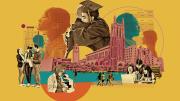How do students prepare for an undergraduate education at the most selective institutions—and what kind of people are they when they get there? How do they choose what school to attend? Once enrolled, what is their experience really like? And what determines how universities become excellent, and whether they can remain so?
Natasha Warikoo, Ed.M. ’97, Ph.D. ’05, indirectly addresses the first question in Race at the Top. After talking with a mother whose children are in the “Woodcrest” public school system, Warikoo (previously an associate professor at the Harvard Graduate School of Education, now professor of sociology at Tufts) found herself “happy that I did not live in a town like hers. I even felt a newfound appreciation for the gentle pace of my own children’s schools—fewer demanding parents, less pressure.” Woodcrest, an East Coast suburb, is one of those affluent communities found around most major American cities where the considerable means at hand are applied to buying the best K-12 schooling possible. The result, in this case, is truly outstanding, in students’ academic attainment, achievements in performing and studio arts, and even in the gentler sports: a case where, in comparison to most school systems, everyone really is above average.
But unlike the quirky Lake Wobegone, Woodcrest is a pressure cooker. The high-school principal recalls parents and children “talking about what college they’re going to go to. Fourth and fifth graders…as they’re driving to playdates.” The culture features “intensive parenting” and youngsters who internalize the need to take four AP courses if someone else is taking three, or five if somone else is taking four.
Warikoo’s larger project is recasting the sociological model of immigration and assimilation. As Woodcrest undergoes a significant demographic transition, resulting in a population that is now 60 to 65 percent white and 30 to 35 percent Asian and Asian American, the newcomers, rather than adopting the prevailing native culture, pose a severe challenge to it by steadily, progressively outperforming white students academically—as measured by GPAs, standardized-test scores, and the difficulty of students’ courses of study. They spend summers and weekends in enrichment courses, and largely eschew time-consuming team sports. The parents of white students are much more supportive of athletic extracurriculars, encourage a vision of their children’s emotional balance and well-being, and reserve the summers for teen jobs, camp, or family vacations. At their behest, and to the Asian parents’ dismay, they get the school system to impose limits on homework. A white parent calls Woodcrest “a factory that makes college applications.”
Warikoo is especially effective in explaining the newcomers’ motivations beyond the clichés about “tiger moms” or some ethnic “Asian” phenomenon. What she sees is the “cultural repertoire” of a successful Asian and Asian American elite, whose path upward led through their home countries’ unrelentingly competitive systems of high-stakes testing, admission to the minuscule number of places at super-elite universities, and subsequent Ph.D.s. That sounds about right.
Putting the sociology aside, and the implications for Woodcrest’s future as a community, what sort of applicants emerge from this process (which is clearly successful at getting a lot of youngsters into the top tier of selective colleges)? Amid lofty parental expectations and school standards, and “a sea of high achievers,” Warikoo found herself talking to driven “kids with somewhere to be, something to accomplish,” who felt “busy and focused” with their own “determination to achieve”—no sense of teens just letting their hair down and having fun. That sounds about right, too.
Woodcrest is near enough to Harvard and MIT (and sufficiently populated with their alumni and professors) that they are almost default choices among Warikoo’s interview subjects: the kind of elite institutions that fit residents’ aspirations and self-images. What of the families who live in towns with comparably fortunate, excellent school systems, but scattered across the continent?
Here, the higher-education ecosystem has adapted to consumer demand in the form of college rankings, none more powerful than the U.S. News & World Report version, née 1983. One glory of American higher education is the diversity of institutions from which to choose (as opposed to the few flagship national universities in high-stakes, testing-driven countries like China). They vary tremendously in the experiences on offer—befitting “an even greater diversity in the needs and preferences and aspirations” that applicants seek to satisfy, as Colin Diver, LL.B. ’68, puts it.
Given those realities, the effects of ratings, he writes in Breaking Ranks, are almost uniformly counterproductive. Unlike consumer goods, students co-produce their own education (what they get out of it depends on what they put in) and the effects are long-term in nature, so reducing the selection process to a numerical ranking is crazy: there is no similarity to a Consumer Reports review of refrigerators. Diver likens “the homogenizing effect of rankings” on diverse colleges and universities to a Procrustean bed: not a good way to find a fit. In resorting to the rankings (he provides plenty of evidence that they influence behavior), students surrender their own agency even before they enter college.
Diver attended Amherst and Harvard Law, served as dean of Penn’s law school and president of Reed College (which declines to particpate in the ratings), and was an Amherst trustee. So he is able to cut down all the low-hanging fruit swiftly. Academic leaders’ assessments of peer institutions—an important component of many rating regimes—are necessarily superficial. Raw endowment and per-student spending data tell little about how resources are applied to undergraduate teaching, graduate training, and research. And so on.
Worse still, the rankings distort institutions’ behavior. If high standardized test scores weigh heavily, merit-based financial aid (divorced from need) is a gateway drug: “[I]ts most glaring drawback is its tendency to exacerbate income inequality,” Diver notes. Why spend $50,000 in institutional funds to support a promising low-income student from an under-resourced school, whose test scores may be below the college’s average, and suffer a ratings penalty, when the same pot can be parceled out in five $10,000 merit grants to high-scoring students who will boost the aggregate test results and the school’s ranking? This is a “reverse-Robin Hood program, fueled by the intense competition for highly credentialed applicants,” particularly among “private nonprofit schools, especially those that are moderately selective and charge high tuitions”: a dismaying example of the larger phenomenon he critiques, the pursuit of “prestige-based rankings.”
In theory, Diver notes, one could conceive “higher goals for higher education” by trying to measure learning outcomes, pursuing information not only on graduates’ career earnings but on career satisfaction, and taking on the hard task of determining how well schools do at overcoming socioeconomic deprivation and enhancing students’ life prospects. He is conversant with all the data, and teases apart superficial measures of, say, graduate indebtedness. (Low debt is often a function of the family wealth of most admitted applicants, and generous aid offered to the handful of truly needy students enrolled.) Done properly, he suggests, a social-mobility index would rank places like City College of New York and Texas A&M in the top tier—and such institutions as Amherst, Penn, Reed, and Notre Dame far lower.
What is to be done? Diver believes that it is worth pursuing a higher education as “a preparation for a geuninely fulfilling life.” The reductionist “rankocracy” did not “create the classist yearning for prestige and pedigree,” but ratings powerfully exacerbated it. “By building their assessment criteria around the perpetuation of wealth and privilege, they reinforced the idea that education serves primarily personal interests, rather than the collective welfare,” in the process “quench[ing] the pedigree-seekers’ thirst for status-signifying labels.”
He suggests ignoring the rankings and examining what one wants from an education: “Formulate a tentative hypothesis about your personal preferences,” and then use publicly available data to identify a range of schools that might satisfy. In other words, act like an empowered learner who will get something out of the expensive, time-consuming higher education one is about to pursue. In the case that one cannot “like Ulysses” figuratively tie oneself to the mast and ignore the ratings’ siren song, he counsels, then use many of them—from U.S. News to Washington Monthly—to get some nuanced perspectives. If educators cannot ignore the rankings, he advises, at least they can junk worthless peer rankings, resist publicizing illegitimate ones, and make accessible the full range of data on their institutions.
Diver is a realistic idealist. He compares eight diverse schools (from Amherst and Berea to the University of Michigan and Notre Dame) and eight hypothetical students for whom they might be a good fit. A lifelong educator, he holds out those examples in the hope that “students will be liberated to find the best path forward to a life of service and meaning. And educators will be liberated to achieve the loftiest ideas of their chosen profession.”
In the meantime, what is college like for those pressured graduates of Woodcrest’s high school, or the applicants obsessed by the purported differences between Berkeley (ranked number 22 one year) and USC (number 24)? In a prodigious act of field research, Wendy Fischman and Howard Gardner, of the Harvard Graduate School of Education, sought to understand The Real World of College through 2,000 structured interviews at 10 different, nonvocational schools, from Cal State Northridge and Ohio State to Duke and Kenyon. (This reviewer was an early reader of and reporter on some of their research: “Campuses’ Cultures,” May-June 2019, page 31.)
The information-gathering preceded the pandemic upheaval on campuses everywhere, but their core discoveries seem even more pertinent today. For all the external—and, increasingly, partisan political—focus on issues such as campus speech, sexual harassment and assault, and racial and ethnic tensions, students and staff members identify “[p]ervasive issues of mental health and belonging.” Startlingly, “Across all participants, nearly half…rank mental health as the most important problem on campus”—one of the few agreements among all participants. In their attempt to assess students’ sense of “belonging” within their school setting, Fischman and Gardner find “a reassuring majority of students indicate a sense of belonging”—but “one-third of students…also express some form of alienation”—from peers, academics, their institution, or some combination of these. Amid these personal concerns, too few students have a clear, focused view of their academic goals.
Fischman and Gardner prescribe more intentional onboarding of students: a deliberate process of orienting them to their school’s academic mission. To help clarify that mission, they also push back against projectitis (the campus tendency to launch new committees and programs to address every want or need identified by members of the community). And to the extent that colleges have a social, religious, or other mission, the authors urge that it be carefully intertwined with the academic one.
Those sensible recommendations loom larger in the context of Fischman and Gardner’s core findings on mental health and belonging. In turn, Warikoo’s depiction of what it takes to compete for a place at the most selective colleges, and Diver’s dissection of the superficial, even misleading “information” about college choices from the rankings, may help to explain the mental-health and alienation problems that appear so alarmingly in Fischman and Gardner’s Real World. If K-12 schooling is reduced to a relentless, pressured pursuit of a “winning” college application, who are the students when they arrive on campus? What sense of community accompanies them to their new surroundings, and what direction for the lives before them when they move on from family and home? Diver, Fischman, and Gardner are proponents of the liberal arts; their progressive elimination from many high-school curriculums, rankings, and students’ mental maps would seem to be consequential. Add external anxieties—from the pandemic and economic uncertainty to war—and students’ needs and their coping mechanisms seem misaligned, to an unsurprising, worrying degree: not a promising posture for a successful college experience.
Finally, what makes for a truly distinguished institution of higher education? A simplistic answer might be to manage to be founded some centuries ago, to have accumulated generous alumni and employed wise investment managers, and to have had leaders who didn’t routinely overspend the resulting resources—the attributes common to almost any of the top-tier schools in the U.S. News league tables.
Not surprisingly, the real answers are much more nuanced, and merit serious scholarly study. Answering the need, William C. Kirby—who holds appointments in both the Faculty of Arts and Sciences (of which he was dean) and Harvard Business School—draws on his deep knowledge of German, American, and Chinese universities to deliver a landmark work, Empires of Ideas. The book, modeled on HBS case studies, probes eight world-class institutions across space and time; the analyses resist brief quotation, but are worthwhile reading for anyone who thinks seriously about the conditions in which such places can thrive (more on that below).
For more casual readers, Kirby, who is also president of this magazine’s board of directors, helpfully outlines principles so basic they may seem obvious, but are not. Among “factors that may make for excellence or decline,” he cites leadership (presidents, chancellors, rectors); the quality of faculty and students; and financial resources. They were first brought together in a powerful, modern way at the Universty of Berlin in 1810, where arose the concepts of an institution “devoted to scientific research at the highest level,” melded with “a commitment to foster a culture of education in the liberal arts and sciences” (as opposed to practical training). The third trait, vital to success, Kirby places in “the realm of governance…that accords the university the autonomy to make its own appointments and set its own priorities, insulated to a high degree from political winds.” The latter factor, he says, is the most important in “the making or breaking of great global universities.”
Germany’s experience, as Kirby narrates it, is telling. That country’s leading academic institutions were crushed twice during the twentieth century, when failures of governance destroyed their freedom of action: the fascist assault in the 1930s and leftist convulsions (combined with underfunding) in the 1960s. In the United States, Berkeley illustrates what happens when an admirable experiment in public higher education is starved of financial support. Harvard, with its every-tub mentality and huge resources, has, heretofore, managed to be excellent in most things it tries to do. And Duke is a model for the strategically planned and driven research university now rising to prominence. China, undertaking higher education on a breathtaking scale, has managed to make Tsinghua a world-class scientific and engineering institution. But the prospects for wider brilliance, Kirby notes, are clouded, to say the least, by an increasingly authoritarian society in which many subjects have been made verboten by party decree.
None of these explanations may matter, today, to the anxious Woodcrest students and their parents, nor to people who fill out their applications with an eye on the U.S. News rankings: near-term users of education services, rather than strategic thinkers about what it means to be an excellent school. But they matter a lot, even existentially, to societies and their access to educational prowess over time. “Harvard’s great wealth allows it to do much more, and at a higher level than any university on Earth,” Kirby writes about the place he knows best. “It maintains a culture of excellence in appointing faculty….Its resources have allowed it to survive its own fiscal mismanagement in and around the recession of 2008. But uniquely among the universities we have encountered in this book, the management and use of Harvard’s resources are still widely dispersed across individual schools, with broadly excellent but inevitably uneven leadership. The university still seems to lack the capacity or even the will to do deep, university-wide strategic planning—the kind of planning that has allowed Duke…to do more with much less.”
In an increasingly competitive and global (at least until China’s recent battening down of the hatches) higher-education marketplace, that disinclination to plan might not be advantageous for Harvard’s future. As other institutions’ endowments close the gap with the Crimson’s cash, and as peers from MIT to Tsinghua seek to recruit the same prospective faculty members whom Harvard craves in fields like computer science, past reputation, as they say, is no guarantee of future success.
Harvard has measurably improved its governance since the 2010 Corporation reforms. That is an essential step forward, given the history Kirby narrates. Strong governance and its role in ensuring the institution’s continued success matter more than ever as the American discourse about universities in states such as Wisconsin and Texas, which have had excellent public research flagships, increasingly turns from championing education to political attacks on institutions’ presumed biases and constraints on their room to debate ideas and tenure professors.
Serious observers of higher education need not worry about the yearly ranking of this or that university. But in Kirby’s telling, a society that cherishes the long-term capacity to do the research that leads to mRNA vaccines and to teach future leaders in the arts, sciences, and professions has plenty to think about.









